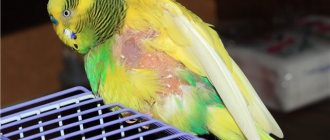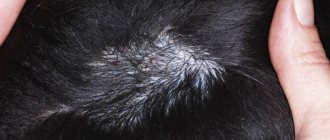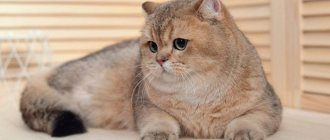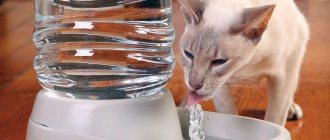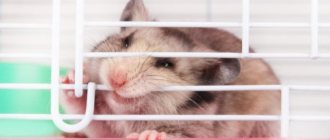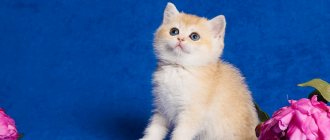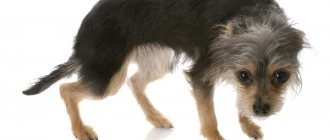Do chinchillas shed and why: causes of hair loss and baldness of a domestic animal
Chinchillas are pleasant animals with beautiful and neat fur. Owners of animals, even with allergies to fur, can keep them without danger to their health. If an animal is observed to shed profusely, natural questions arise: how natural is this for the animal? A concern is when chinchillas lose hair on their sides.
Causes of hair loss
The chinchilla is an unpretentious animal and usually brings only joyful troubles to its owners. Clean, neat animals have a funny and cute appearance. It does not leave fur behind, unlike cats and dogs.
But this does not mean that they never shed. This process is ongoing for them. But no more than two dozen hairs can fall out per day, so shedding is invisible. Inconspicuous hairs can be seen on the bedding in the cage. An intensive molting process occurs during the period of change from children's fur to adult fur.
If your chinchilla is losing a lot of hair, and this is not juvenile shedding, you should be wary.
Stress
Experiencing a stressful situation can cause hair loss. Chinchilla is an emotionally and mentally very vulnerable animal. They have increased sensitivity to any changes in their lives. They do not tolerate moving, new people well, and are wary of new objects. They have a hard time experiencing forced separation from their owner and the death of other pets.
Stress causes fur to shed in clumps, which quickly leads to bald patches. The problem can only be solved by creating a calm environment for the animal. Your favorite one needs to be given attention and affection, and treated with treats. Household members do not need to raise their voices in the presence of a rodent. This measure will definitely work. Within a few days the hair will stop falling out.
Avitaminosis
With an unbalanced diet, when the rodent is given few fresh fruits and vegetables, as well as during the winter and spring periods, the chinchilla may develop vitamin deficiency.
At risk are young animals, females bearing offspring and older animals. If vitamin deficiency is in an advanced form, bald areas of the body turn red, begin to itch and peel.
The issue is resolved by the following measures:
- Enrich the rodent's diet with foods containing vitamins A, C and D. Carrots, pumpkin, celery, and tomatoes are rich in carotene. Sweet peppers are the record holder for vitamin C content. D contains barley in large quantities.
- Freshly cut hay from meadow grasses (timothy, meadow fescue, sudanese, wheatgrass) should be present in the diet constantly.
- It is necessary to put mineral stones in the cage.
- An intensively shedding animal needs to add the vitamin preparation Multitabs to the water (1 drop per 100 grams of water).
Chinchilla owners sometimes try to inject vitamin preparations intramuscularly. This process is very painful. You can get the opposite effect: the chinchilla will shed due to the resulting stress.
Vitamin preparations cannot be overdosed to avoid hypovitaminosis. This extreme provokes poor health of the animal.
Dermatitis
Dermatitis is extremely rare in chinchillas. They have a high immunity to this disease, but it can occur if the animal is poorly cared for.
The chinchilla's hair grows, it begins to itch intensely, bites problem areas, which quickly become bald. To establish an accurate diagnosis, you need to show your pet to a veterinarian. There are many drugs that can help get rid of this problem.
In natural conditions, chinchillas take baths made of volcanic sand. This way they get rid of possible parasites, remove excess moisture from the coat and restore the body’s defenses.
In captivity, your pet can be offered river sand. It is first calcined in a frying pan, freeing it from pathogenic microorganisms, cooled to room temperature and poured into a container convenient for the animal. If you offer such exercise to your pet from time to time, dermatitis will not be terrible.
Allergy
A rodent is just as susceptible to an allergic reaction as a person to certain irritants. This is individual for each animal. Therefore, if a chinchilla is shedding, then you need to consider the allergic nature.
Signs of allergic dermatitis:
bald and inflamed areas, scratching, redness of mucous membranes, sneezing, heavy breathing due to swelling of the nasopharynx.
Allergens can be:
- new type of feed;
- bedding material;
- recently changed attributes in the cage.
Once the allergen is eliminated, the animal’s health will be restored. Sometimes antihistamines are additionally prescribed to improve well-being.
A detected allergy in an animal is a sign that the pet has a breakdown in the body’s defenses. It is necessary to review the diet, strengthen nutrition, ventilate the room more often, and walk the animal in the fresh air.
Fungal infections
Chinchilla shedding may be associated with a dangerous fungal disease such as lichen.
Bald patches appear on the animal’s body, which have characteristic signs of lichen:
- the skin is covered with scales of dried epidermis;
- the affected area is slightly swollen;
- a pink and red border appears.
The animal needs to be treated urgently, otherwise it may go bald. A chinchilla infected with lichen should not be allowed out of its cage so that it does not infect other animals or household members. There's no need to panic.
This serious fungal disease can be treated quickly with ointments and medications for internal use.
In the early stages, chlorhexidine, pharmaceutical sulfur, clotrimazole, and lamisil help.
As the disease progresses, in addition to ointments, use tablets as prescribed by a veterinarian.
The cage containing the rodent is thoroughly washed with baking soda and scalded with boiling water. Equipment is disinfected daily. If measures are taken immediately, the spread of lichen can be stopped at the very beginning.
Disadvantages in care and maintenance
The rules for caring for and maintaining a pet are not complicated, but if they are not followed, this will immediately affect the appearance and condition of the animal’s fur coat. Before purchasing a rodent, you need to prepare a comfortable and safe home, equip it with accessories, and stock up on a variety of food.
Errors in diet preparation
If a chinchilla sheds, and this is not associated with the natural process of adolescence, you need to reconsider the diet.
Animals that are fed monotonous food are at risk. Natural vegetables, fruits, herbs cannot be replaced by any concentrates. New types of food should be introduced gradually, otherwise there may be problems with digestion.
Incorrect conditions of detention
The temperature in the room where the animal spends most of its life plays a huge role in its well-being. Chinchillas do not tolerate heat, stale, stale air, or dampness very well. Comfortable temperature for animals is +15… +22℃. +26℃ is considered critical. In the heat, the chinchilla's fur will fall out in clumps, and the skin on the bald patches will be red and dry.
The same problem occurs in animals whose cages are placed close to radiators, in the kitchen area, on window sills, in places exposed to direct sunlight. Rodents tolerate lower temperatures much more easily.
If the region where chinchillas are kept involves hot summers, it is necessary to provide ventilation and air conditioning systems.
Why does a chinchilla chew its fur?
Sometimes chinchilla owners observe the phenomenon of gnawing out fur. This is no longer molting, but mechanical damage to the coat.
This behavior of the animal can be caused by various reasons, the most likely are the following:
- the pet is not given enough attention;
- genetic predisposition to such a habit;
- the animal is in a tight cage;
- chinchillas are bitten by fleas.
They begin to determine the reason for “biting off” fur with a simple thing: they pay more attention to the animal, buy it a new toy, set up mazes and other attractions. Breeders recommend a minimum cage size of 70x70x50. In reality, this is very little for a chinchilla. If your pet starts chewing fur, you should think about expanding the space.
It is necessary to carefully examine the animal's fur coat for fleas. The eggs of these parasites can easily be introduced with sand or shoes from the street. Lice eaters and ticks can attack an animal while walking. To get rid of fleas, it is enough to put on a flea collar designed for rodents on your chinchilla. Do not use products intended for other animals.
How to deal with hair loss in chinchillas
As soon as it is noticed that your pet’s hair is falling out rapidly, or bald patches have appeared on the body, you need to identify the probable causes and immediately begin to deal with it.
The set of measures aimed at preventing hair loss in animals includes:
- treatment with drugs prescribed by a veterinarian;
- elimination of factors that provoke an allergic reaction;
- introduction of fruits, vegetables and herbs to the nutrition menu;
- soldering the animal with vitamin and mineral supplements;
- improving the indoor microclimate;
- prevention and destruction of ectoparasites.
If you treat the animal carefully and start treatment on time, you can deal with the problem quickly.
Let's sum it up
A hairless chinchilla is not a very pleasant sight. Wool can fall out for various reasons: disease, improper living conditions or the natural process of molting. It is not always possible to figure out this issue on your own. Therefore, the first thing you need to do is show the animal to a veterinarian in order to rule out diseases and start treatment on time.
Source: https://homjakam.ru/shinshilla/zdorovie/linyayet
Why can a chinchilla's hair fall out?
Owners of chinchillas sometimes face the problem of hair loss in animals. They immediately associate this phenomenon with some disease. In this case, ordinary molting is overlooked. This process is typical for any animal with fur. It is connected with the fact that hair renewal is underway.
Of course, there are cases when hair loss begins completely out of season, and then we can already draw a conclusion about the presence of some kind of illness. Next, we will consider in more detail how seasonal hair change differs from diseases and how to deal with hair loss in a chinchilla.
Concept of juvenile molt
Any healthy animal undergoes fur replacement at one of the stages of growing up. This is typical not only for chinchillas, but also for other species. Specifically, in these animals, the onset of juvenile molting occurs at one year of age, and the duration stretches for several months.
Chinchilla shedding
Stressful situations
Very often, hair loss occurs as a result of some negative event or stress. Like all other rodents, chinchillas are highly sensitive to the following factors:
- change;
- moving;
- the emergence of new people;
- new items in the cage;
- the appearance or death of another domestic animal;
- lack of communication with the owner.
When a stressful situation occurs, the fur begins to come out in large quantities in clumps, which is the reason for the appearance of bare areas on the animal’s body. The problem can be solved quite simply:
- providing the chinchilla with a calm environment;
- attention from the owner;
- gentle and calm treatment;
- introducing the animal’s favorite treats into the diet.
Such measures can be considered sufficient to ensure that hair loss stops after a few days.
Skin diseases (dermatitis)
Here is another reason why hair loss begins. The problem may lie in skin diseases, which are often accompanied by severe itching, inflammation and hair loss. If a chinchilla has a good immune system, then the manifestation of dermatitis is quite rare. This disease can be of both an allergic nature and a fungal one.
Chinchilla dermatitis
Fungus
Fungal infections cause diseases such as trichophytosis and microscopy, otherwise these ailments are called lichen.
The diseases have similar symptoms: it all starts with the appearance of regularly defined oval or round scaly or blistered areas on the chinchilla’s skin.
Then hair loss begins, and if you miss the moment and do not carry out treatment, then in a very short time the animal will become completely bald.
If the veterinarian confirms the presence of lichen, the owner should remember that the disease is very contagious and can be transmitted to humans. Animals are treated with injections, tablets, sprays, ointments - it all depends on the degree of damage.
Misfeeding
A lack of vitamins in an animal’s body, or vitamin deficiency, occurs very often due to the fact that the feeding diet is incorrectly formulated and consists of monotonous food. Most often, chinchillas encounter vitamin deficiency in the spring or autumn, because there is a reduction in succulent green food, due to the fact that it is very difficult to get it.
The lack of vitamins is accompanied by deterioration of the coat, which is manifested by its loss in whole tufts. Vitamin deficiency is often mistaken for dermatitis or the presence of ectoparasites due to the similarity of symptoms (redness of the skin, peeling).
Incorrectly composed diet
Overcoming vitamin deficiency is quite simple:
- introduction of vitamins or injections into the diet, which include veterinary drugs containing essential microelements;
- Along with food, they give fresh fruits, vegetables, and herbs.
Vitamins are given for 14 days, dosage occurs individually for each animal.
Vitamins in excess lead to hypervitaminosis, one of the signs of this disease is also loss of fur, and in addition to this symptom, problems develop:
- with cardiovascular activity;
- breathing;
- digestion.
Content problems
Often, a chinchilla’s fur begins to fall out even if the owner does not take into account how the animal lives in its natural habitat.
During the heat, the chinchilla finds voids in the rocks, which are located in the north, where there is no direct sunlight.
Animals get used to coolness, and therefore they are not suitable for rooms where the temperature is set high. The ideal regime for a chinchilla is no more than +20°C.
With the onset of winter, you should not move the cages closer to heating devices; in the summer, animals should be protected from direct sun. With the onset of heat, it is recommended to connect air conditioners.
Chinchilla chews fur
Some owners begin to notice how their pet chews out its fur. This is most commonly seen in the limb, flank or tail area. This behavior should not be attributed to a natural change of coat and should not be thought of as molting.
Gnawing fur
Gnawing its fur may be a reaction to the stress it has been exposed to, but most often this behavior signals that the chinchilla is bored. To correct the situation, the following methods are recommended:
- transplant the animal into a freer enclosure;
- buy toys;
- spend more time with your pet.
What to feed a chinchilla
For adequate nutrition of the animal, the owner will have to provide the following food:
- rough (branches, hay, bark);
- fresh herbs (in season);
- vegetables and fruits;
- compound feed.
When preparing your diet, you should consider some nuances:
- the animal's need for nutrients;
- age characteristics and gender;
- health;
- physiological state;
- season.
One adult chinchilla can eat 50-65 grams of food per day, if we talk about the amount of food per day, then the approximate diet is as follows.
*the animals have a very positive attitude towards various delicacies. As a treat, they choose various fruits and berries, as well as feed additives purchased in specialized stores. Most of all, chinchillas love:
- fresh apple, melon, pear;
- raisins, dried apricots, prunes;
- rosehip and hawthorn berries.
Treat for chinchillas
To diversify the diet, it is recommended to alternate fruit and berry treats. When training, it is best to choose treats that can be purchased at a pet store. But all good things should be in moderation; overfeeding with goodies leads to serious health problems for a chinchilla.
What chinchillas shouldn't do
There are a number of products that should not reach animals. You can see them in the following table.
Problems with hair loss are not uncommon for chinchillas.
Excessive hair loss is a signal that something may be wrong with the animal (the exception is seasonal shedding, as well as juvenile shedding).
If the breeder does not have specialized education, it is recommended to invite a veterinarian to make the correct diagnosis and prescribe appropriate treatment.
Source: https://fermers.ru/zhivotnovodstvo/drugie/vypadenie-shersti-u-shinshilly
Avitaminosis
One of the reasons why a chinchilla sheds may be vitamin deficiency. A chinchilla's diet should be varied. In addition to special dry food, the animal should be given fruits and vegetables rich in various vitamins. When fed poorly balanced food, the chinchilla's fur becomes faded and brittle, and it begins to fall out.
In case of vitamin deficiency, it is worth reviewing your pet’s diet. It is necessary to choose only high-quality food recommended by breeders. Also, the animal’s diet must include: hay, apple, carrots, oat and wheat sprouts, dry strawberry, rose hip and hawthorn leaves. It is necessary to consult a veterinarian who will prescribe a course of vitamins for the animal.
What to do if your chinchilla's hair is falling out. Why does a chinchilla shed?
One of the most common reasons for concern among chinchilla breeders is the animal's excessive shedding.
Many people think that chinchillas do not shed at all and begin to panic when they notice even a few hairs on a brush or while cleaning the apartment.
However, contrary to popular belief, it is normal for a chinchilla to constantly renew its coat. More dangerous symptoms are excessive hair loss or zonal baldness.
Poor nutrition
Hair can fall out in clumps throughout the year as a result of improper and unbalanced nutrition. This is most often observed in animals that eat only one type of food.
Breeders mistakenly assume that expensive and high-quality granulated food can replace all natural food and provide the pet with all the vitamins and minerals. As a result, the animal may have a deficiency of one or more vitamins and an excess of other elements.
If hair loss is caused by improper feeding, you should gradually change your diet.
A sudden change will lead to stress and digestive problems!
The animal should be given more dried leaves of fruit trees, berries and fruits, pure vegetables and fresh herbs.
Incorrect content
One of the most important factors when keeping chinchillas is temperature. Animals cannot tolerate heat and elevated temperatures, stuffiness, and high humidity. The most comfortable temperature for babies is +15 +20 degrees, and the critical temperature is +25 +27.
If the critical temperature remains in the room for several days, the animal may begin to go bald, the fur will fall out in clumps, and the skin on the bald areas will become dry and reddened. It is easier to prevent a problem than to solve it.
It is not recommended to place the cage next to heaters or radiators, or on a window in direct sunlight. Chinchillas tolerate cold temperatures much easier, so even if the room is below +15 in winter, you should not turn on the heating devices. A little colder weather won't do any harm.
If the animals are kept in a climate where hot summers are the norm, then care should be taken to have a fan or air conditioner in the room where the cage is located.
Lack of attention
Another reason for the appearance of bald patches and hair falling out in clumps is gnawing out the fur. This reason cannot be attributed to molting, since baldness is caused by mechanical damage. However, gnawing out fur is a fairly common occurrence in animals that are not given enough attention or that are kept in cramped and small cages. The emergence of a bad habit is caused by ordinary boredom.
And the fur of the animal very often looks as if tufts of wool were pulled out of the skin. It is quite easy to cope with this problem - pay more attention to your pet, move the animal into a more spacious cage, install new toys or labyrinths, or buy a pair.
Source: https://NaLugah.ru/zhivotnovodstvo/shinshilly/chto-delat-esli-u-shinshilly-vypadaet-sherst-pochemu-shinshilla-linyaet.html
Fur chewing
Quite often, chinchillas chew out their fur with their teeth, which is why they look disheveled and sloppy. In addition, these animals are not averse to ruffling their neighbor’s fur. The exact reasons for this phenomenon are unknown, but chinchilla fur is believed to be chewed out for the following reasons:
- stress;
- such behavior is often observed in emotionally unstable and nervous animals and is inherited;
- pregnancy and breastfeeding cause hormonal stress in the female, and also cause a lack of vitamins in the body;
- unbalanced diet and poor quality feed;
- high room temperature;
- illness;
- lack of attention and boredom.
Why does a chinchilla shed in patches and what to do in this case?
For its beauty and unusually soft fur, the chinchilla is considered the most expensive rodent in the world. The owner of a cute face, funny ears and tail has established herself among breeders as an intelligent, good-natured and unpretentious animal.
The fur coat, as a source of pride for a chinchilla, is a layer of tight and very delicate fluff that prevents the animal from freezing in the most severe frosts. The chinchilla is rightly called hypoallergenic , which makes it possible for a person suffering from attacks of fur intolerance to choose a rodent as a pet.
Causes of unnatural shedding
Living in its natural habitat and taking into account the geographical location of its natural range, the chinchilla has not acquired genetic diseases and is very tolerant of changes in its diet.
A change in the main part of the coat occurs when the baby grows up and this is the only natural molting of a rodent. Unlike other animals, the chinchilla does not shed depending on the changing seasons and the process of molting in an adult is gradual . Caring for and maintaining an animal at home is not difficult.
Therefore, abnormal molting is a source of concern for the pet’s health. Common causes include skin diseases and nervous overload of the pet.
Dermatitis
It cannot be said that dermatitis occupies a leading place among skin diseases in chinchillas.
Thanks to their excellent natural characteristics and strong immunity, rodents rarely suffer from dermatitis. However, insufficient attention of the owner to the condition of the pet's fur can lead to scratching, frequent biting and baldness of the skin.
To treat an animal, you must visit a veterinarian to prescribe medications.
Sand baths will help prevent the occurrence of dermatitis. In nature, to protect themselves from parasites, chinchillas bathe in volcanic sand. The finely ground substance absorbs excess moisture well, protects against colds and supports the overall well-being of your pet.
Gnawing fur
A common occurrence in chinchillas is hair chewing. Upon external examination of the pet, the fur resembles an exotic haircut, with the sides, paws and tail most often affected.
Since the animal trims its own pieces of fur on its own, this does not apply to shedding.
Why does a chinchilla lose its fur in clumps, as if shedding? Sometimes such actions can be a reaction to a stressful situation after an injury or surgery. But often, a chinchilla with such behavior lets the owner know that she is bored .
In this case it will help:
- Moving to a larger cage.
- Providing additional toys.
- Additional attention from the owner to the pet.
To identify unnatural molting, you need to carefully monitor your pet and find out the causes of the phenomenon. If you have any doubts about self-treatment, you should contact your veterinarian to prescribe medications.
It must be remembered that the development of the disease in such a small creature occurs very quickly and there is a risk of losing your pet.
Source: https://xvostus.com/shinshilly/bolezni-sh/linyaet.html
Treatment
Often, only a doctor can answer the question of why a chinchilla sheds a lot. If an animal has a lot of hair loss, first you need to analyze the conditions under which it is kept. It is worth protecting the animal from stress and checking the temperature of the room where the cage is located.
In the case of allergic dermatitis, it is important to find the cause that caused the allergic reaction in the animal's body. It is worth reviewing your pet’s diet and eliminating all prohibited foods from it. You can experiment a little with food and bedding to determine the source of the problem.
If an animal has lichen or other diseases, only a veterinarian can make an accurate diagnosis. The doctor must examine the animal, take blood and scrape the skin for analysis. Depending on the identified source of the disease, drug treatment will be prescribed.
Why does a chinchilla shed and lose its fur?
Many pet owners get seriously upset when their chinchilla's hair falls out. It's often scary, but it's usually a completely natural process. It is important to be able to distinguish the process of normal molting from the symptoms of dangerous diseases in your pet.
Why does a chinchilla shed?
Like most other animals, chinchillas shed to freshen up their coat. This is similar to how a person sheds dead skin cells. Shedding chinchillas is a way for them to refresh and maintain a healthy coat.
Washing your pet is strictly not recommended, because this is almost the only way for him to cleanse himself without unnecessary stress. If your chinchilla is hairless because she constantly sheds her fur, it means that you are handling her too roughly. Don't grab it by the tail, don't try to catch it.
Let your communication be more relaxed, then you will definitely make friends.
chinchilla shedding
Chinchillas also shed to control their temperature. It is difficult for them to regulate their body temperature, but it is vital. Heat can lead to serious health problems.
So in the warm season they need to shed excess fur to prevent overheating. During the spring and summer, you may notice that your chinchilla is losing more hair than usual.
This is a natural process that keeps them healthy.
Owners of exotic rodents often wonder whether chinchillas shed as a result of age-related changes. It is impossible to give an exact answer to this question, since everything is quite individual. Rather, on the contrary, the animal stops molting due to disturbances in heat exchange, which at a young age works “like a clock.”
It is also important to find out whether chinchillas kept at home shed from this or that type of food. In fact, hair loss is usually caused by a lack of vitamins. The animal should receive only balanced nutrition; skimping on the quality of food for a chinchilla can cost it health or even life.
How does the molting process work?
Chinchillas can shed at intervals of several weeks. The process of shedding their fur starts from their head and moves towards the tail. New fur begins to grow and pushes out the old one.
During this process, you can notice a clear line on the fur. This line, known as the primer line, is the area where the fur coat is currently being renewed. The line will gradually move down the entire body until the coat is completely renewed. The animal wears a new coat for several weeks before it is time to begin the molting process again.
The process occurs all year round, however it can be noted that animals shed more fur in the summer or spring to keep cool than in the winter months.
Shedding fur
Shedding fur should not be confused with the natural process of shedding.
A chinchilla should shed slowly and regularly. Therefore, if a chinchilla is completely bald, perhaps something has frightened it very much.
Rapid fur release is a defense mechanism used when a chinchilla feels trapped or threatened. Animals often use this in the wild, for example if a chinchilla is caught by a predator. But pet chinchillas can also shed fur if they are in a stressful situation.
Shedding fur is also a natural process and should not cause much concern to pet owners. If your hairless chinchilla is feeling normal, carefully inspect all exposed areas of his skin. You don't need to go to the vet or treat the bare skin area unless it starts to look painful.
Danger of hair loss
Hair loss is a natural process. This is harmless and even necessary, because it is this process that keeps the chinchilla healthy. But there are several problems and features associated with hair loss that every chinchilla owner should be aware of:
- If an animal loses too much of its fur, it may be tempted to eat or lick the excess fur. If an animal consumes too much of this fur, it may experience digestive problems or intestinal obstruction. So make sure to clean the cage regularly to remove excess fur.
- Excess fur sometimes gets stuck in your pet's coat. This fur can lead to many problems with the animal's skin.
These are the 2 most serious problems that can lead to the development of health problems in a chinchilla.
Is it worth caring for a chinchilla?
So, regardless of why a chinchilla sheds, and given the dangers of matting the fur, it is worth knowing what kind of care your pet requires during this period. Grooming your pet regularly is a process that can really help remove excess fur to prevent matting. But this process is not always easy.
Chinchillas in the wild do not clean their fur in any way other than wallowing in the ground or sand. So your pet may show serious resistance when trying to clean its coat with a brush. But still, some chinchillas even like it when they are brushed, then they will simply curl up and fall asleep during the procedure.
The owner of a chinchilla should constantly study the personality of his pet, especially when trying to care for his fur. Never force your chinchilla to groom itself. This can cause your chinchilla unnecessary stress, resulting in an overall hairless chinchilla.
If your chinchilla does like to be groomed, try to brush him regularly to remove excess fur. This is especially important for chinchillas with thick coats because they are more prone to matting.
You should also allow your chinchilla to take regular dust baths. They mainly use this to remove dust and oils from the surface of the skin and fur.
But it can additionally help remove excess fur through the natural brushing process. Chinchillas need dust baths several times a week. Once the bath is complete, be sure to remove the bath from the cage.
Excessive dust baths can also lead to serious skin problems.
Source: https://mychinchilla.ru/problemy-zdorovja/pochemu-shinshilla-linyaet-iu-nee-vypadaet-sherst.html
Why does a chinchilla lose hair and shed hair?
If you notice that your chinchilla is shedding a lot of hair, this may be a cause for concern.
Keeping these animals at home creates a minimum of problems for their owners. The most important thing is to properly prepare for the arrival of this cute and charming pet. You need to buy and equip a cage, stock up on food and treats, purchase a bathing suit and zeolite dust for it. Unlike dogs, chinchillas do not need to be walked.
There is no need to find a place for a litter box, as is the case with a cat or ferret. By keeping the cage clean, your guests will never guess that you have an animal at home - that is, if we talk about the specific smell. With good care, chinchillas do not smell.
And, of course, there is no need to constantly clean the fur of a shedding animal from the carpet or clothing.
Do chinchillas shed? It is believed not. In reality this is not entirely true.
- Firstly, there is the so-called juvenile molt. This is when the cub changes into an adult fur coat.
- And secondly, in nature and under normal conditions at home, chinchilla fur changes almost constantly.
But she sheds 20-30 hairs a day, which is almost unnoticeable. Moreover, this does not affect the fur of the animal, especially considering the thickness of the fur.
If your chinchilla is shedding, it is worth knowing what could be causing this phenomenon. The reasons for hair loss can be:
- stress,
- hypovitaminosis or vitamin deficiency,
- dermatitis.
Stress
Most often, a chinchilla's hair falls out as a result of a stressful situation. Like many rodents, they are very sensitive to change, moving, new people, objects, and even the appearance or death of other pets. When stressed, fur usually falls out in clumps, profusely and can lead to the rapid appearance of bald patches. The solution to this problem is very simple - a calm environment, more attention and affection, calm speech and more favorite treats. Most often, this is enough and after a few days the hair loss stops.
